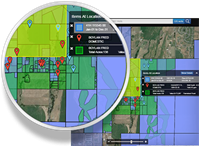Water Rights Consulting and Technology
Published on by Dylan Winbourn, Senior Sales Engineer at EcoSys in Business
Montana water rights are based on the appropriation system, meaning that the earliest rights are the most valuable.
The deadline to timely file claims for water rights in use as of June 30, 1973, i.e. historical water rights, was April 30, 1982. Many of these historical water rights date back to the late 19th century.
As you can imagine, finding information to substantiate claims that were filed 35 years ago based on events that happened over a century ago does not lend itself to quick Google searches.
Instead, I have driven around Montana to County Clerk and Recorder’s Offices, District Courts, government offices and historical libraries to search through fragile, barely legible documents; archived photos and maps; microfiche; and microfilm.
As I explained in a previous post, I have worked in Montana water rights for over 20 years, and I am presently a water rights consultant for Ponderosa Advisors.
 Some water rights research still requires traveling to find original documents, old deeds, photos and court files, but technology is quickly improving access to information. Photo archives, historic maps, land records and Montana aerial photos are all available online.
Some water rights research still requires traveling to find original documents, old deeds, photos and court files, but technology is quickly improving access to information. Photo archives, historic maps, land records and Montana aerial photos are all available online.
One of the most powerful online tools I use is Water Sage, an interactive database application that links water and land information for several western states, including Montana. Ponderosa Advisors created Water Sage™ by collecting data from several government agencies and making it accessible from a map. I can access DNRC water right abstracts, water right claim files and detailed land parcel information from the application.
I can also export water and land information to a spreadsheet, Google Earth, or a GIS file. Once I have exported the basic information to a spreadsheet or GIS file, I use Excel and QGIS to refine and customize the index and map without wasting time typing in basic information.
Even though technology can save time, consultants, engineers and lawyers resist change. It seems easier and cheaper to maintain the status quo, but in the long run resistance to technology wastes time and money for the client and the consultants, engineers and lawyers. Company decision-makers often feel that spending money to purchase a program that will cut billable hours (and income) doesn’t make any sense.
This logic escapes me. Providing the best possible service is the way to win new clients and keep existing ones. And, for attorneys, failure to use technology may violate ethics rules. A recent American Bar Association article1 warned attorneys that lack of competency in basic tech leads to overbilling and possible ethics violations:
The seemingly-innocuous decision to skip technology training can lead to overbilling. And if you are deliberately avoiding technology because it means that you can bill more, then you are definitely overbilling. […] This is not “just business”—this behavior is an ethical breach.
Aside from ethical considerations, saving time and money for a client makes the consultant more competitive and productive. Instead of billing a client for mundane tasks that can be completed more quickly by using technology, the client’s money is better spent for field investigations, digging through old dusty boxes of files, creating customized GIS maps and using the information collected to solve problems with paper water rights and water use.
Even though technology has saved me a lot of time, I’m glad nothing has replaced those trips to towns in Montana to spend hours at the Clerk and Recorder’s Office or the Clerk of Court’s Office, because it is nice to get away from my desk sometimes and enjoy the beautiful scenery.
Attached link
http://watersage.com/blog/list-blog/july-2017/july-14,-2017-water-rights-consulting-and-technol/Media
Taxonomy
- Water Rights
- Human Rights
- Empowerment & Right To Water
1 Comment
-
would this include prices paid and volumes?